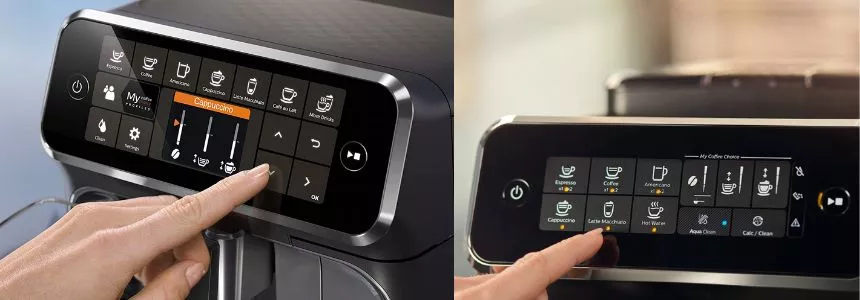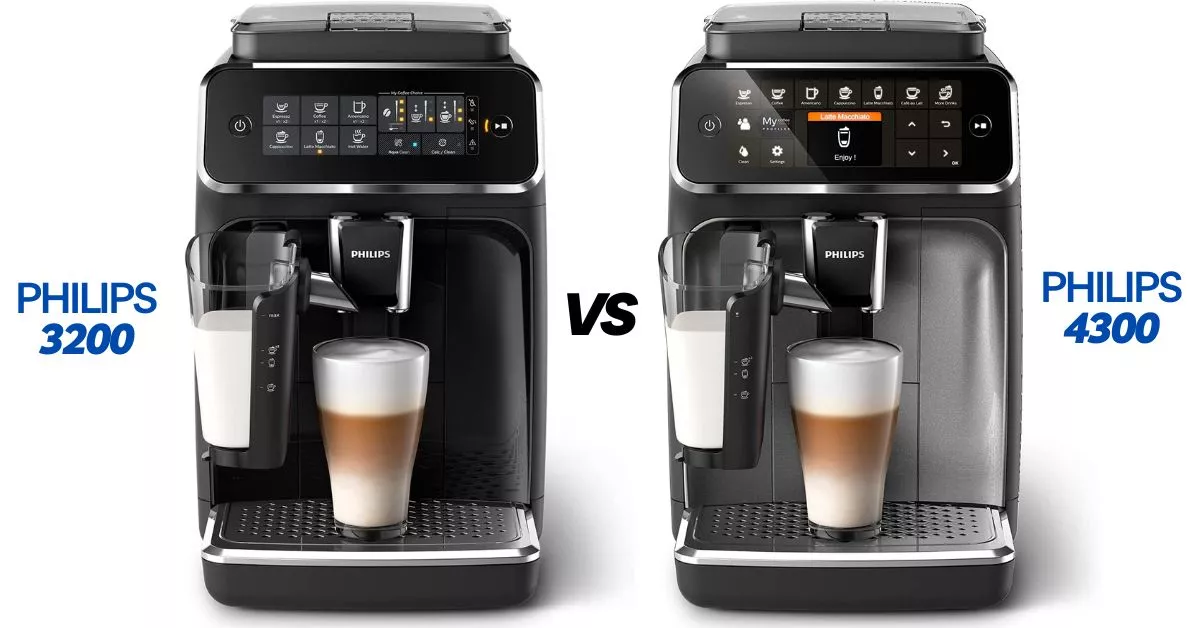Coffee – when freshly brewed, holds the aroma that revives us every day for new beginnings entwined with technological innovation. Going through the era of the evolution of coffee makers or machines, not only explains brewing modifications but also embarks positive lifestyles of coffee enthusiasts.
I have personally used both the Philips 3200 and 4300 models and have experienced the difference between the two machines firsthand.
The Philips 3200 and 4300 are great coffee machines offering unique features to cater to different coffee lovers. However, choosing the right model can be a daunting task, especially for someone who is new to the world of coffee machines.
In this article, I will share my experience with the Philips 3200 and 4300 LatteGo models and compare their design and build quality, coffee brewing capabilities, ease of use, price, and overall value. I hope my personal experience and analysis will help you make an informed decision when choosing the perfect coffee machine to fit your needs.
So, let’s get started and explore the Philips 3200 vs 4300.
Straight To The Point..
The Philips 4300 Latte Go is one step above as compared to Philips 3200 – involving few modifications, but apart from that both have similar specifications in major.
The Philips 4300 offers eight variations in drinking means three extra drinking options, whereas the Philips 3200 has five drinking selections including only espresso, cappuccino, regular coffee, latte macchiato, and americano.
Unique to the 4300 comprises a TFT mini display, unlike the Philips 3200.
On the basis of aroma settings, coffee strength, brewing temperature, and milk volume settings in each drinking cup, the Philips 4300 offers five different levels of adjustment rather unlike the 3200 which has three settings levels.
A worth buying additional feature in the 4300 is the option of two user profiles and a guest profile where you can save any customized drink of your preference, which the 3200 doesn’t possess. Lastly, the 3200 model is less expensive compared to the 4300.
Philips 4300 vs 3200 LatteGo Specifications
| Specification | Philips 3200 | Philips 4300 |
|---|---|---|
| Model number | EP3221/40 | EP4347 |
| Removable brew group | ✅ | ✅ |
| Housing material | Plastic | Plastic |
| Color options | Black | Black/Silver |
| Milk frother | LatteGo | Integrated carafe |
| User interface | Touchscreen | Color TFT with buttons |
| User profiles | ❌ | ✅ |
| Removable water reservoir | ✅ | ✅ |
| Water reservoir capacity | 60.9 fl oz / 1.8 l | 60.9 fl oz / 1.8 l |
| Number of boilers | 1 | 1 |
| Pump pressure | 15 bar | 15 bar |
| Maximum cup height | 6.9 in / 17.5 cm | 6.9 in / 17.5 cm |
| Minimum cup height | 3.3 in / 8.4 cm | 3.3 in / 8.4 cm |
| Grinder | Ceramic flat burr grinder | Ceramic flat burr grinder |
| Grind adjustment levels | 12 | 12 |
| Bean hopper capacity | 9.5 oz / 270.0 g | 9.5 oz / 270.0 g |
| Pre-ground coffee bypass | ✅ | ✅ |
| Grounds discard container capacity | 12 | 12 |
| Specialty drinks | 5 | 8 |
| Pre-infusion | ✅ | ✅ |
| Adjustable coffee temperature | ✅ | ✅ |
| Adjustable milk foam temperature | ❌ | ✅ |
| Adjustable milk temperature | ❌ | ✅ |
| 2-cup function (non-milk drinks only) | ✅ | ✅ |
| Hot water function | ✅ | ✅ |
| Hot milk function | ❌ | ❌ |
| Milk foam only option | ❌ | ✅ |
| Water filter | ✅ | ✅ |
| Power consumption | 1500 W | 1500 W |
| Weight | 17.7 lb / 8.0 kg | 17.7 lb / 8.0 kg |
| Dimensions | 9.7 x 14.6 x 17.0 in | 9.7 x 14.6 x 17.0 in |
| Warranty | 2 years | 2 years |
| Price | Check Price | Check Price |
Philips 4300 Overview
As someone who has used the Philips 4300 LatteGo, I can say it is a fantastic mid-range super automatic espresso machine. The detachable milk carafe makes cleaning a breeze, and its milk is thick and light, perfect for a latte macchiato. Although it may be too intense for a cappuccino, it’s not something that I would complain about, especially considering its price point.
One of the things I love about this machine is the variety of drinks it can make. You can select espresso, ristretto, coffee, and americano, and there are three milk drink recipes to choose from café au lait, latte macchiato, and cappuccino. If you have pre-ground coffee, the pre-ground coffee bypass is an excellent feature to use.
The customization options are endless, from grind setting to coffee temperature, which is why the espresso from this machine is so great. With two user profiles and one guest profile, you can save your customized drinks for later use.
Cleaning the machine is effortless, with most of the parts being dishwasher safe. However, I would recommend hand washing them to avoid any dishwasher residue or etchings. The AquaClean filter that comes with the machine helps to extend the time between descaling, and the guided program on the machine ensures that you are doing it correctly.
Overall, the Philips 4300 LatteGo is an excellent investment for anyone looking for a mid-range super automatic espresso machine. It’s easy to use, customizable and produces high-quality drinks.
Philips 3200 Overview
The Philips 3200 is another super automatic espresso machine that is a great choice for those looking for an easy and convenient way to make coffee. With its compact design, it can fit easily into any kitchen, and its intuitive interface makes it easy to use.
One of the standout features of the Philips 3200 is its bean-to-cup functionality. This means that the machine grinds the beans right before brewing, ensuring that you get a fresh cup of coffee every time. The milk frothing capabilities are also impressive, producing creamy and frothy milk for lattes and cappuccinos.
The machine offers five brewing options and customizability, allowing you to adjust the strength and temperature of your coffee. The touch display indicators make it easy to navigate the options and select your desired drink. While it doesn’t have as many milk drink recipes as the Philips 4300, it still offers the classic latte and cappuccino options.
Cleaning the Philips 3200 is also relatively easy, with most of the parts being dishwasher safe. However, the machine does require regular maintenance, including descaling every few months.
In terms of price, the Philips 3200 is a more affordable option compared to the Philips 4300. It may not have all the bells and whistles of the 4300, but it still produces high-quality coffee and is a great option for those on a budget.
Philips 3200 vs 4300 – Key Features
Design & Build
From my experience, the Philips 3200 and 4300 share similar designs and builds. Both machines have a sleek and modern appearance, with a glossy black finish and silver accents that give them an attractive look.
The machines have a top-loading bean hopper with a capacity of 275g, enough to make several cups of coffee without refilling. The front-access water tank has a capacity of 1.8 liters, which is also a good size for making multiple cups of coffee.
The drip tray and cup warmer on top are both detachable, making it easy to clean and maintain the machine. The LatteGo container sits at a slight angle over the steam spout, and is also easily removable for cleaning.

Both machines have the same footprint and dimensions, with the 4300 being slightly heavier at 17.63 lbs compared to 16.53 lbs for the 3200. However, this difference in weight is hardly noticeable.
One potential downside of the design is that both machines are only available in black with a glossy finish and silver accents. This means that if you don’t like this color scheme, you don’t really have any other options to choose from.
Overall, the design and build of both the Philips 3200 and 4300 are solid, with a modern and attractive appearance!
Coffee Flavor
When it comes to coffee flavor, in my experience, the Philips 4300 may have a slight edge over the Philips 3200. Both machines produce great-tasting coffee, but I have found that the 4300 consistently delivers a richer and more full-bodied flavor. This could be due to its higher-end features, such as the adjustable ceramic grinders and the Aroma Seal technology, which helps to retain the coffee’s aroma and flavor.
Additionally, the 4300 has more customization options, allowing you to adjust your coffee’s strength, temperature, and volume to your personal preferences.
Ceramic Grinder
The ceramic grinder in the Philips 3200 and 4300 is a great feature, and it has definitely lived up to its advertised capabilities. I have found that the grinders consistently produce very even and smooth coffee grounds, and they operate quietly. It’s difficult to find another super automatic espresso machine with such a high-quality grinder at this price range.
With 12 available settings, we can adjust the texture of the coffee grounds and the strength of the espresso shot according to our preferences.
I have found that setting the grinder to levels 5-9 produces the best results, depending on the desired strength of the espresso. If you set the grinder to level 12, the coffee comes out too bitter and watery, and there is little to no crema. On the other hand, setting the grinder to levels lower than 4 results in coarse grounds, which produce weak and sour shots.
It’s important to note that Philips recommends waiting until you’ve brewed 100-150 cups, or about a month, before adjusting the grinder settings. This is because the machine needs to settle in and adapt to your usage patterns. I would also suggest not changing the settings too frequently, as it can affect the regular operation of the machine.
Display Panel

The 4300 model boasts a no-nonsense user interface that I like. Its color TFT screen is easy to control using the buttons around it, and the layout is straightforward, making it easy to understand. The most popular drinks are front and center, and a button to switch user profiles is conveniently located on the screen. You can customize each drink using the arrow buttons, and the More Drinks button offers options for milk froth and hot water. The caffé crema and ristretto options are also available here.
As for the 3200 model, I appreciate the clear front-panel indicators, which are great as long as the main functions are working correctly. The machine comes with five preset coffee options. You can adjust all the key parameters using the corresponding three-step scale icons. The machine even allows you to draw hot water if you remove the LatteGo System. It’s an almost ideal package, isn’t it?
Milk System
The Philips 4300 comes in two models, one with a classic milk frother that includes a steam wand and one with the LatteGo carafe system. I’ll focus on the LatteGo. The LatteGo carafe is removable, which I find convenient as I can pour in the exact amount of milk I need and store any remaining milk in the fridge. Cleaning is also a breeze as the carafe breaks into two pieces, exposing the steam chamber for easy access. However, it’s worth noting that the LatteGo system doesn’t produce hot milk only, as it will lightly texture the milk when dispensing. Nonetheless, you can dispense hot milk foam only if you need to make a customized drink, and you can adjust the length of the milk foam, which is a plus.
On the other hand, the Philips 3200 has a milk system similar to the Philips 5000 LatteGo series, and it’s touted as hot stuff. The system consists of just two easily cleaned parts and doesn’t have any tubes of its own. In my experience, the milk system on the 3200 is superior to the 4300 even though they both have a Integrated carafe. The 4300 fails to deliver dry and airy foam, which is essential for making cappuccinos and lattes, unlike the 3200, which produces microfoam and allows me to engage in latte art.
Special Coffees
The Philips 4300 offers a wider range of brewing options to suit different tastes and preferences, including:
- Espresso
- Cappuccino
- Coffee
- Ristretto
- Latte Macchiato
- Café au Lait
- Americano
- Caffé crema.
Meanwhile, the Philips 3200 has a more limited selection of
- Espresso
- Cappuccino
- Coffee
- Ristretto
- Latte Macchiato
User-Friendliness
The Philips 4300 is designed to be very user-friendly, with clear instructions and feedback provided on its screen. This makes it easy for anyone to operate, even if they have never used an espresso machine before.
In contrast, the Philips 3200 can be a bit more difficult to use, as it relies on a system of lights to convey information about its functions and any errors that may occur. This can be confusing for users who are not familiar with the machine, and they may need to consult the manual or online resources to figure out what the lights mean.
Overall, the Philips 4300 is the more accessible and intuitive machine, making it a better choice for those who value ease of use.
Water Reservoir
The Philips 4300 and 3200 models feature a removable water tank with a capacity of 60 ounces (1.8 liters), making cleaning and refilling easy. Additionally, Philips provides a complementary water filter that sits inside the water tank, ensuring a consistently delicious cup of coffee.
Cleaning & Maintain
One great feature of the Philips 3200 and Philips 4300 is their built-in alarm system that alerts you when it’s time to descale and clean the machines. Additionally, their brew groups are removable for deep cleaning on a monthly or weekly basis. These machines also come equipped with automatic rinsing and a complete cleaning cycle to ensure that the brew path remains odor-free and bacteria-free.
However, it’s important to note that the steam wands should be rinsed after each brewing session to prevent them from getting damaged due to lack of cleanliness. So, be sure to wash the milk path with a quick rinse after every time you froth milk with the steam wand.
AquaClean Filter
Both are equipped with an AquaClean Filter. The AquaClean filter is a water filtration system developed by Philips for use in their coffee machines. It is designed to remove impurities from the water, such as chlorine, to improve the taste of the coffee and protect the machine from mineral buildup. The filter sits inside the water tank and needs to be replaced periodically, depending on the frequency of use and water hardness.
By using the AquaClean filter, you can enjoy up to 5,000 cups of coffee without the need for descaling, making it a convenient and cost-effective solution for coffee lovers.
Aroma Strength Settings
The 4300 offers five aroma settings to choose from, giving you the flexibility to brew a bold coffee or an extra strong latte macchiato. The 3200, on the other hand, only has three aroma settings available.
Final Verdict – Philips 3200 vs. 4300
Based on my experience, I found both machines offer excellent value for money. Still, if you’re looking for a more sophisticated experience, I would recommend the Philips 4300 LatteGo over the 3200, especially if you enjoy experimenting with different drinks or need consistent performance day after day. The 4300 is an excellent investment for anyone who values a high-quality espresso machine without breaking the bank.


